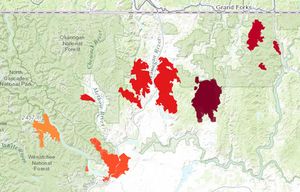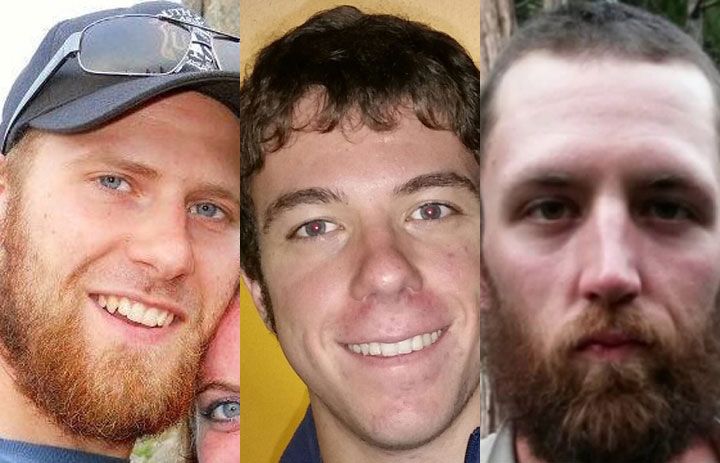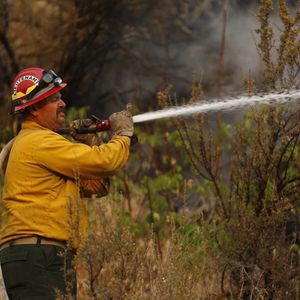Wildfires continued to rage out of control Thursday, prompting state officials to seek firefighting help from volunteers for the first time in history.
A day after a rampaging wildfire near Twisp killed three U.S. Forest Service firefighters and injured four others, large blazes burned out of control across Washington as gusting winds pushed flames over parched wild lands and broadened a statewide crisis.
By Thursday, the Okanogan complex fires had exploded over bone-dry terrain in the North Cascades, tripling in size, consuming or threatening dozens of homes and outbuildings and displacing hundreds of people.
Incident commander Nathan Rabe fought back tears as he considered the loss of life and described the overwhelming intensity of the battle.
Related: Firefighters to homeowners: ‘no time for heroics’
Most Read Local Stories
“We’re seeing fires and fire growth that I have not seen much of in 35 years of doing this,” he said.
The crisis is so bad that for the first time in history, the state Department of Natural Resources (DNR) is accepting offers from people wanting to help fight the fire or donate equipment.
About 5,400 homes had been evacuated, with orders to leave immediately given to residents in Twisp, Winthrop, Conconully, Riverside, Tonasket, parts of Omak and in more rural areas outside towns. Okanogan County Emergency Management officials announced new evacuation areas on their Facebook page Friday morning.
Overall in Okanogan County, about 35 structures had been confirmed destroyed as of Thursday afternoon. But emergency officials acknowledged blazes had devoured dozens of other homes and structures that had not yet been tallied.
“We don’t know how high that number’s going to climb,” said Angela Seydel, a spokeswoman for the Okanogan County emergency operations center. “We just know many people have lost their homes.”
Dozens more homes and other structures have been destroyed over the past week in a separate fire in the Chelan area.
Maurice Goodall, the county’s director of emergency management, said Thursday the fire came within a mile and a half of Omak the night before.
Goodall said he watched houses burn from his yard and spent the night spraying water on the 250 tons of hay stored in his barn.
Residents of Conconully had to be escorted to safety as fire burned on both sides of the only major road out of town.
By early Thursday, the fatal Twisp fire — a blaze that erupted Wednesday afternoon and raced toward the towns of Twisp and Winthrop, forcing evacuations in both — had grown to more than 7,800 acres, sending billows of brownish smoke across the Methow Valley.
“We did get somewhat of a line around it,” Okanogan County Fire District 6 Chief Don Waller said Thursday morning. “But it’s not controlled by any means whatsoever, and we’re starting to see the winds pick up.”
That fire is one of 17 large blazes burning across more than 400,000 acres in Washington.
Related: Firefighters killed near Twisp: ‘three big heroes protecting small towns’
DNR had deployed more than 1,000 firefighters to the Okanogan fires alone, while hundreds of other federal and local firefighters are battling others throughout the state, officials said.
John Fox, a meteorologist for the National Weather Service, warned that gusting winds up to 46 mph forecast at times through Friday night would only make matters worse.
“All you have to do is add winds or oxygen to a fire, and it’s kind of like using a bellows on the fireplace, ” Fox said.
Gov. Jay Inslee and members of the state’s congressional delegation arrived in Chelan on Thursday to get briefed on the response effort. In a conference with reporters, Inslee called the fires ravaging Washington “an unprecedented cataclysm in our state.”
Some state lawmakers wrote to President Obama urging him to approve “as quickly as possible” the federal emergency-disaster declaration Inslee requested Wednesday. That would mean more resources and money for the state.
Related video: Aerial view of wildfires burning across North Central Washington
Wildfires are raging throughout the state, and a dry, windy forecast calls for worsening conditions across North Central Washington. Read more. (Bettina Hansen / The Seattle Times)Thursday evening, Commissioner of Public Lands Peter Goldmark said DNR was setting up a coordination center to handle offers of help or equipment.
“We appreciate all offers of qualified and trained support,” Goldmark said in a statement. “If people want to help, we’d like them to contact our coordinators so we can work on getting them safely and appropriately involved.”
Two centers — at Omak City Hall and the state Department of Transportation office in Colville — will organize training sessions for those not currently qualified to serve on the fire line.
“Even if a member of the public has sufficient credentials, deployment to a wildfire will depend on the availability of professional-firefighter staff to accompany, direct and ensure the safety of everyone concerned,” a news release said.
Anyone interested in volunteering via Omak can call 360-826-2546 or email CRC.Omak@gmail.com; via Colville call 509-675-7847 or email CRC.Colville@gmail.com. Offers will be reviewed starting at 7 a.m. Friday.
Twisp River fire
Nearly 60 people who fled their homes as the fatal Twisp fire bore down stayed overnight at a Red Cross shelter at the Brewster Middle-High School, officials said.
Despite evacuation orders, not everyone was leaving their homes.
Rob Risely, 63, filled up several cans of gas late Thursday morning at a filling station in Twisp. Risley is using gas-powered pumps to pull water from a creek to dampen his seven-acre property outside town.
“We have fires above us, below us, on both sides,” said Risely. “All the way around us.”
Throughout the morning, fire trucks from Gig Harbor, Monroe, Chelan County and South King County rumbled through town, along with trucks hauling bulldozers on flatbed trailers.
Goldmark described the Twisp fire Thursday as having “pretty explosive growth.” The fire’s cause remains unknown.
Local and state law enforcement joined federal and state officials at the scene of the fatalities early Thursday to investigate, even as the bodies of the dead remained at the scene.
Given the deaths of the firefighters Wednesday, Goldmark said people shouldn’t undertake “heroic” acts just to save buildings.
“It’s a grim reminder of how dangerous it is” to fight these fires, he said.
Four other lightning-sparked blazes burning northwest of Omak exploded by Thursday morning amid erratic winds, consuming and endangering more homes.
Dan Omdal, a spokesman for the Okanogan Complex Incident Command, said he drove from Conconully to Okanogan through the blaze late Wednesday, with flames spreading through the forests and rangelands around him.
“Telephone poles were being engulfed and wires were snapping,” he said.
Collectively, the four blazes grew by about 60,000 acres by early Thursday.
Gary Bland came back Thursday to check on his home north of Omak and found it intact — mostly.
His lawnmower was reduced to a heap of charred metal, and burned power poles left transmission lines sagging ominously. But the house and shop were spared, largely because of the precautions he started several days ago.
“We’ve been running the sprinklers 24 hours a day, rotating them around the property to keep things wet,” he said.
Also near Omak, Claire Painter surveyed the charred remains of two of her horses Thursday. She managed to get several others to the county fairgrounds before the flames swept through Wednesday night, but these two were half-wild animals she had been trying to tame, and they refused to be led into the trailer.
“That one didn’t trust anyone,” Painter said, pointing to one.
As she spoke, wind fanned embers in her neighbors’ field. Painter jumped into her truck and sped off, returning a few minutes later with a tractor to plow up the ground and contain the blaze. She was soon joined by several friends and neighbors with hoes and a water truck.
After more than half an hour, the flames were gone. But the winds continued to blow and it wasn’t clear the blaze wouldn’t flare up again.
The winds provided at least one silver lining.
“It has cleared out some of the smoke,” Seydel said “So this will allow our air support, which has been grounded because of poor visibility, to get back into the air to help fight the fires.”
The largest of the Okanogan blazes, known as the Lime Belt fire, has merged with the smaller Blue Lake fire and expanded to nearly 48,000 acres outside Conconully. That blaze endangered at least 95 structures at latest count, though some of those homes likely were destroyed, officials said.
The fires cut power and forced closures to the main road through town. Evacuation orders were given to Conconully’s 200 residents, but Omdal said Thursday townspeople weren’t necessarily fleeing.
“You have some rugged individualists up here who want to protect their property,” Omdal said. “I talked to one of the local folks yesterday who said that 80 percent of the residents are still there.”
Another blaze, known as the Tunk Block fire, was burning about four miles northeast of Riverside, spreading to more than 31,000 acres and threatening about 50 homes, Omdal said.
And late Thursday, the town of Tonasket was ordered to evacuate because of a fast-moving fire northwest of town. Amanda Mieirs, a waitress at Whistler’s Family Restaurant, said the smoke from the fire was so thick that you couldn’t see the mountains nearby, and it penetrated the buildings.
“I heard it is three miles from here,” Mieirs said about 7:30 p.m. “My boss called and told me to shut down and get out of here.” Residents were told to go to Brewster.
Other nearby blazes included the Beaver Lake fire, now at more than 3,800 acres, and the Nine Mile fire, a 4,720-acre blaze burning near the town of Oroville and across the border into Canada. That blaze, now 90 percent contained, has destroyed at least three homes and 32 other buildings, including eight historic cabins, Omdal said.
Chelan area
Five Chelan wildfires grew to a combined 123,000 acres Wednesday night, said Wayne Patterson, a spokesman for the Chelan complex fires.
And late Thursday afternoon, they were still growing.
“We’re probably in the 30 to 40 mph (wind) range as forecast, so fire activity has definitely picked up in the last several hours,” Bill Queen, a spokesman for the Chelan Complex Incident Command, said in the early evening.
At least 47 homes and 37 outbuildings have been burned in the five area fires. Rich Magnussen, a Chelan County emergency-management specialist, said Thursday about 1,400 people have evacuated.
One of the blazes — the Wolverine fire, which has been burning for almost two months near Holden Village — “popped out a little” from its fire line, Patterson said.
Some crews working the Chelan blazes were sent to Okanogan County to help fight the Twisp fires.
With nearly 100 large fires burning nationwide, everybody is thin for resources across the country, he added.
“We’ve been one of the highest-priority fires in the nation,” Patterson said. Still, “We have outstanding orders” for more resources.
Five helicopters and two airplanes were assisting the nearly 1,000 firefighters there, he said.


